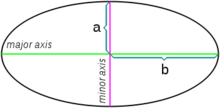Prolate spheroid

A prolate spheroid is a spheroid in which the polar axis is greater than the equatorial diameter. Prolate spheroids are elongated along a line, whereas oblate spheroids are contracted. The prolate spheroid is defined by the equation for some arbitrary constant c, in prolate spheroidal coordinates.
Properties

A prolate spheroid with b > a has surface area and volume .
The prolate spheroid is generated by rotation about the major axis of an ellipse with semi-major axis b and semi-minor axis a, therefore e may be identified as the eccentricity (see ellipse). A derivation of this result may be found at.[1]
Uses
The prolate spheroid is the shape of the ball in several sports, such as in Rugby union, Rugby league, and Australian rules football. In American football and Canadian football, a more pointed prolate spheroid is used (one resembling a vesica piscis in cross section).[2]
Several moons of the Solar system approximate prolate spheroids in shape, though they are actually scalene. Examples are Mimas, Enceladus, and Tethys (satellites of Saturn) and Miranda (a satellite of Uranus). In contrast to being distorted into oblate spheroids via rapid rotation, celestial objects distort slightly into prolate spheroids via tidal forces when they orbit a massive body in a close orbit. The most extreme example is Jupiter's moon Io, which becomes slightly more or less prolate in its orbit due to a slight eccentricity, causing spectacular volcanism. It should be noted that the major axis of the prolate spheroid does not run through the satellite's poles in this case, but through the two points on its equator directly facing toward and away from the primary. A famous example in science fiction is Jinx in Larry Niven's Known Space.
It is also used to describe the shape of some nebulae (nebulas) such as the Crab Nebula.[3]
The most common shapes for the density distribution of protons and neutrons in an atomic nucleus are spherical, prolate and oblate spheroidal, where the polar axis is assumed to be the spin axis (or direction of the spin angular momentum vector). Deformed nuclear shapes occur as a result of the competition between electromagnetic repulsion between protons, surface tension and quantum shell effects.
Many submarines have a shape which can be described as prolate spheroid.
See also
- Equidimensional
- List of solar system objects by mass
- Oblate
- Prolate spheroidal coordinates
- Reference ellipsoid
- Spheroid
- Triaxial
References
- ^ http://mathworld.wolfram.com/ProlateSpheroid.html
- ^ See 2008 NCAA Football Rules and Interpretations, Sec. 1, Art. 1
- ^ Trimble, Virginia Louise (October 1973), "The Distance to the Crab Nebula and NP 0532", Publications of the Astronomical Society of the Pacific, 85 (507): 579, Bibcode:1973PASP...85..579T, doi:10.1086/129507
{{citation}}: CS1 maint: date and year (link)



